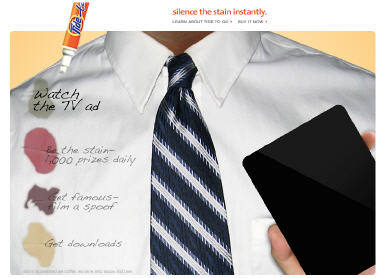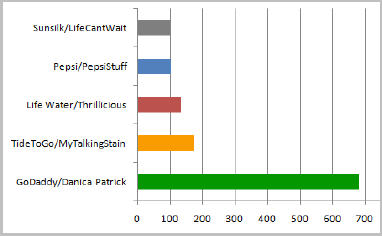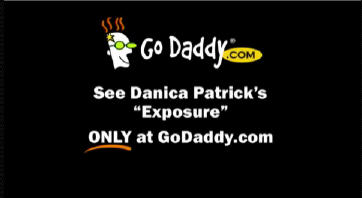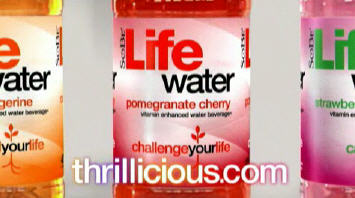-
From an Online Video Perspective, Super Bowl Ads Are a Mixed Bag
The great Super Bowl game last night was once again not matched by the quality of the ads, at least when viewed for how well they leveraged online video. For several years now, I've been arguing that the $2.5-3 million that advertisers spend on their 30 second Super Bowl spots could yield a far higher ROI if they figured out how to extend their experiences through online video. So once again this year I've reviewed all of the Super Bowl ads - not for how funny, creative or gross they were - but for how well they took advantage of the benefits online video offers.
First, some basic stats: of the 58 ads that ran during the game last night (which I viewed this morning at CBSSports.com), 38 of them were tagged with a URL and 20 were not. On a percentage basis that's about equal to last year, when 37 of the 56 ads carried a URL. Of the 38 ads with a URL, only 4 of them explicitly urged the viewer to see more or watch more at their web sites:
-
Focus On the Family - The controversial Tim Tebow advocacy ad invites viewers to visit the Focus web site to see the full Tebow story. The site has a long interview with Tebow's parents along with lots of other video. Regardless of your politics, the ad works well as a friendly teaser for viewers to learn more about the organization.
-
Boost Mobile - Jim McMahon and the hilarious rapping NFL players take it to a new level by actually ending their rap with the line "Go online to find the rest of our jam," then exposing the URL. Further videos at the site continue the fun.
-
GoDaddy - The web site hosting company was back with its ads featuring Danica Patrick and teasing viewers to "See more now at GoDaddy.com." The scantily-clad GoDaddy girls concept is a little stale now, but for the male-dominated game audience, there's no doubting its appeal.
- HomeAway.com - My personal favorite, this vacation home rental company bought back Chevy Chase and Beverly D'Angelo as The Griswolds for "Hotel Hell," a spoof of the famous "Vacation" movie series. The ad is totally focused on getting viewers to see the film at HomeAway.com. Chase is a classic and the videos are very clever.
Outside of these four, a handful of others are on my honorable mention list. From a user involvement standpoint, CareerBuilder's provocative ad with workers walking around in their underwear (which was the result of its "Hire My TV Ad" contest) was a winner and built on the success Doritos has had with its own $1 million user-generated contest. Monster.com has an interesting engagement opportunity at its site, allowing users to create their own "Fiddle a Friend" music videos with their violin-playing beaver. Speaking of animals, you had to love Bridgestone Tires' "Whale of a Tale" ad featuring 3 guys trying to drive a whale back to the ocean - Bridgestone makes behind the scenes clips here.For more behind the scenes, Dove's new Men Care line features an interview with MVP Drew Brees, who's also shown lathering up in the shower (a blatant pitch to women as well as men). E-Trade was back with its talking babies, but this year with a twist, allowing site visitors to send their own "Baby Mail" emails. The new Honda Accord Crosstour features a well-produced video of the car, though no mention of the video is made in its game ad. And how about the futuristic Vizio ad trumpeting its Internet-connected TVs? It's surely a sign of many more connected device ads to come in future years.
Lastly, a few real misses. First up, what's the deal with Budweiser? It ran 9 ads and not one of them carried a URL. These folks are mistaken in thinking that viewers wouldn't be interested in more about the Clydesdales on the web. Beyond the horses, it would have been cool to learn more about how Bud made the human bridge ad, or did the voice effects in the T-Pain spot. Ditto for Denny's which was promoting its Grand Slam breakfast hard, but didn't do any web tie-ins. The movie ads make me nuts too. They roll the credits so fast at the end of the ad and the text is so small that it's nearly impossible to find a URL to learn more about the movie, even if you wanted to.
The Super Bowl is the biggest event on the sports and advertising calendars, yet as evidenced by this year's performance, most brands and agency creative types still don't fully understand the power of online video. Sure, the post-game galleries drive millions of additional views, but I continue to contend they could be so much more. Oh well, onto Super Bowl XLV.
What do you think? Post a comment now (no sign-in required).
Categories: Advertising, Sports
Topics: Boost Mobile, Focus on the Family, GoDaddy, HomeAway.com, Super Bowl
-
-
Last Super Bowl Post - I Promise
I promise, this will be my last post on the Super Bowl ads. I suspect some of you are getting sick of hearing about them, but the reality is that there are some cool follow up tidbits emerging that I think many of you will be interested in.

First a clarification. I accidently omitted mentioning Audi as another Super Bowl advertiser that had a broadband component to their ad. Their mention of "TruthInEngineering" at the end of their spot was so quick that I didn't even notice it. That's a shame, because when you visit the mini-site there's a lot of great video, including one lasting 3 minutes all about the making of the ad.
Ken Liebeskind has a good interview with Paul Venables, who is the founder and co-creative director of the ad agency that created the spot and the videos at the mini-site. I really like how well developed the whole "Truth In" concept has been executed in the mini-site. My only gripe with the execution of the TV spot is that just flashing "Truthinengineering.com" at the end for a quick second is insufficient to really optimize traffic flow. Though Venables says traffic is way up since the game, I think it would be far higher had they focused on the URL longer.
Meanwhile, some interesting follow up stats that have bubbled up. comScore is reporting that 13% of Super Bowl viewers watched an ad online and that 13% visited an advertiser's web site. Of those who visited an advertiser's web site, 38% visited GoDaddy.com, 22% Coca-Cola and 21% Pepsi.
YouTube's AdBlitz Gallery provides the number of views for all the ads. The top 5 list is currently: SoBe LifeWater/Thrillicious (740,094),
Derek Jeter/G2 (677,686), Bridgestone/Scream (564,986), ETrade/Talking Baby (530,397) and CareerBuilder/Queen of Hearts (442,273).Lastly, the Cincinnati Enquirer is reporting that MyTalkingStain.com, the mini-site TideToGo promoted, had received 30,000 visits by the end of Sun night and already had 5,500 customized ads created. The UGC contest at the site invites users to create their own spoof of the Super Bowl ad. In my opinion, Tide To Go gets top honors for making all the right moves: A clever game spot. Great promotion to the mini-site. Great engagement opportunities and payoffs for consumers. I think it's a model for future Super Bowl advertisers to follow.

Ok, that's it. Now I'll shut up about Super Bowl ads, until 2009.
Categories: Brand Marketing, Sports
Topics: Bridgestone, CareerBuilder, Coca-Cola, ETrade, G2, GoDaddy, Pepsi, SoBe LifeWater, YouTube
-
A Little More Super Bowl Fun
OK, today no rant, just one more little insight to offer from Super Bowl ads.
Yesterday I highlighted the 5 ads (out of the total 52) which had a broadband component. They were:
GoDaddy - promoting Danica Patrick's "Exposure" banned ad and other videos
TideToGo - promoting "MyTalkingStain.com" a fun microsite
SoBe LifeWater - promoting "Thrillicious.com" a microsite where 2 more spots with the dancing lizards can be seen
Sunsilk - promoting "LifeCantWait.com", a microsite with a UGC contest which is not yet active
Pepsi - promoting "PepsiStuff.com", where users can download videos and music
I'm able to track click-throughs to each link I share in these emails. I thought you might be interested to see a graph of these clicks from yesterday. Note they're shown as an index, not actual numbers, with a starting index value of 100 for Sunsilk.

As you can see, VideoNuze email recipients expressed a pretty strong interest in the GoDaddy.com Danica Patrick ad. I'm sure many of you are not surprised since it has a pretty overt potential payoff for visitors.
Though the specifics of that payoff (is Danica actually going to remove her jacket and expose herself?) are very enticing, I think the larger issue to pay attention to is: how can advertisers explicitly use suspense, uncertainty and payoff to drive audiences to do something? Here's the last frame of the Danica spot:

To make this more tangible, consider this: The SoBe LifeWater ad was easily the most impressive use of special effects of all the Super Bowl ads. No doubt the SoBe LifeWater folks spent heavily making the ad, and then paying supermodel Naomi Campbell to dance with the pack of lizards to Michael Jackson's "Thriller." It certainly qualifies as the kind of thing that people would be interested in seeing more of, had SoBe LifeWater teased fans the right way at the end of the ad.
But they didn't. Instead, they simply flashed the URL "Thrillicios.com" at the end of the spot. Nothing was said about what to expect there, why you should go there, what surprises were in store, etc. (In fact there are 2 very funny and clever "episodes". And by the way, does this imply a new Life Water iguana series? Who knows?). Here's the last frame of the SoBe spot:

The point is this: I think SoBe LifeWater missed a huge opportunity to keep viewers engaged, which would have both improved the ROI on their Super Bowl ad spend, and also deepened viewers' engagement with the brand. While the Campbell spot was hugely entertaining, it did little to power ongoing engagement. Contrast this with GoDaddy, which no doubt had people pouring into its web site since the spot ran, with ongoing chatter and brand-building taking place.
As I said yesterday, advertisers need to understand how to use broadband video to evolve Super Bowl ads from having big-time entertainment value to having big-time engagement value. Some like GoDaddy get this, while many others, like SoBe LifeWater, are still on the learning curve.
What do you think? Post a comment and let us know!Addendum - I missed this piece in AdAge "GoDaddy Super Bowl Spot Sets Web-Traffic Record." The "Exposure" on-air ad drove 2 million visits to the site, during the game alone, a record for GoDaddy since it began advertising on the Super Bowl. And no doubt a multiple of that since the game ended. More evidence that GoDaddy nailed it big-time.Categories: Brand Marketing, Sports
Topics: GoDaddy, Life Water, Pepsi, Sunsilk, Super Bowl, TideToGo
-
My Rant About Super Bowl Ads
I love the Super Bowl ads as much as anyone. I never stop being amazed by the creativity and humor on display during each year's big game. This year was no exception: screeching squirrels, a strutting heart,
 shrunken heads, talking babies, the list goes on. For what Super Bowls ads are and always have been, they're terrific. My problem is that I believe broadband video allows Super Bowl ads to be much more than what they are and always have been. But the agency world does not seem to be getting this message.
shrunken heads, talking babies, the list goes on. For what Super Bowls ads are and always have been, they're terrific. My problem is that I believe broadband video allows Super Bowl ads to be much more than what they are and always have been. But the agency world does not seem to be getting this message.Two years ago I wrote "The Ten Million Dollar Super Bowl Ad?", where I outlined a scenario under which a 30 second spot could someday go for ten million bucks. How? By combining the best of brand advertising (the big emotional play) with the best of online advertising (the big measurable, performance-oriented play).
I wrote in that post: "What I envision is that the 30-second spot during the game will become the viewer's introduction or re-introduction to the brand or product. Numerous online, broadband-centric tactics will follow, with video being the center of the action. In football terms, the 30-second spot will morph from throwing a long pass (which is accompanied by high drama, but low probability of an actual score) to executing a more consistent ground game (accompanied by lower drama, but a much higher probability of an actual score). With this added measurability and a direct feedback loop, marketers will have much less anxiety about whether to ante up for the big game (and therefore the price will spiral upward).
I thought agencies and marketers would see this light and rush toward it. Boy was I over-optimistic. After watching all 52 Super Bowl ads this morning (thanks AOL), I am completely dismayed to report that, by my count, only 5 ads had any broadband video component:
GoDaddy - promoting Danica Patrick's "Exposure" banned ad and other videos
TideToGo - promoting "MyTalkingStain.com" a fun microsite
Life Water - promoting "Thrillicious.com" a microsite with a 2nd spot with the dancing iguanas
Sunsilk - promoting "LifeCantWait.com", a microsite with a UGC contest which is not yet active
Pepsi - promoting "PepsiStuff.com", with Amazon (ok, more focused on music than video)
All of the other 47 ads, representing tens of millions of dollars of clients' money, followed the same game plan from Super Bowls' past: go for either the clever, the funny or the gross, in an attempt to create buzz and fond memories for fans.
For me, this hidebound behavior showcases agencies at their most disappointing: unable to break out of the box, recognize new consumer engagement opportunities for their clients or embrace new technologies. Their inability or unwillingness to be more progressive is at the heart of why the whole advertising industry is in such chaos, with an increasing share of total spending shifting to online each year.
Nonetheless, I remain a long-term optimist. Maybe I'm crazy, but I'm still betting that someday, somehow, more agencies and brands will wake up and realize what the 5 brands above did this year: the combination of on-air and broadband is how to score a touchdown.
What do you think? Post a comment and let us all know!
Categories: Advertising, Sports
Topics: GoDaddy, Life Water, Pepsi, Sunsilk, Super Bowl, TideToGo
Posts for 'GoDaddy'
|



